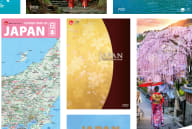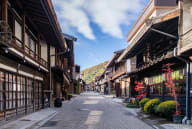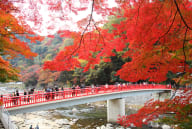
Aomori Delicious from Ocean to Orchard
A Culinary Journey in Aomori
Located in the northernmost part of Honshu, the main island of Japan, Aomori Prefecture boasts a rich natural environment that provides an abundance of unique ingredients. The region's cold winters, cool summers, and proximity to the sea contribute to the exceptional quality and diversity of its produce. Aomori is renowned for offering safe and wholesome agricultural products, thanks to its low pest prevalence and minimal pesticide use, meeting the needs of health-conscious consumers.
Aomori is particularly famous for its apples, which are celebrated for their sweetness and versatility in local cuisine. The prefecture is also one of Japan's leading producers of fresh seafood, including garlic, burdock, scallops, squid, and tuna. In particular, Oma tuna is a Pacific bluefin tuna that is famous for its high quality. Aomori is also renowned for its distinctive seafood dishes, such as Hachinohe's specialty, Ichigo-ni, a savoury sea urchin and abalone soup.
Each area within Aomori has its own specialty dishes that showcase local culture and ingredients. From hearty vegetable soups like Kenojiru to miso-based fish soups like Jappajiru, Aomori's cuisine captures the essence of its unique climate and culture, offering a rich array of flavours and textures.
Learn more about some of the popular local foods that highlight Aomori's culinary excellence.
Ichigo-ni (Sea urchin and abalone soup)

What it is (Ingredients)
Ichigo-ni is a traditional soup from Aomori consisting of quickly boiled sea urchin and abalone. The key ingredients consist of freshly caught sea urchin, prized for its creamy texture and briny flavour, paired with abalone, a rare and highly nutritious shellfish celebrated for its tender texture and delicate taste. The broth is seasoned with bonito flakes and soy sauce, enhancing the umami of the ingredients themselves.
History/Origin
Ichigo-ni, originating from the coastal areas of Aomori where sea urchin fishing has been a tradition for centuries, began when fishermen boiled and enjoyed freshly caught sea urchins and abalone with sea water. The name "Ichigo" translates to strawberry, inspired by the vibrant appearance of sea urchins submerged in the translucent milky white soup, which resemble wild strawberries in the morning mist. In Aomori, it holds a special place as an essential dish for celebratory occasions like weddings and New Year's festivities.
Where to Eat
You can enjoy Ichigo-ni at traditional Japanese restaurants and izakayas throughout Aomori Prefecture, particularly in coastal towns like Mutsu and Hachinohe. In Hashikami Town, the Ichigo-ni Festival is held annually in late July, offering Ichigo-ni at special event prices.
When to Eat
It can be enjoyed year-round, but it is especially popular in July when sea urchins are in season. However, the warming soup is especially comforting during colder weather, making it a popular choice among locals and tourists alike seeking to experience Aomori's rich gastronomic traditions.
Experience the delightful flavours of Ichigo-ni and delve into Aomori's maritime culture with this iconic flavourful soup.
Shoga miso oden : Ginger miso stew

What it is (Ingredients)
Shoga Miso Oden is a hearty and flavourful simmered dish from Aomori. It is made by simmering various ingredients in a broth primarily composed of soy sauce and bonito flakes, then serving them with a miso sauce mixed with grated ginger. Alongside the typical oden ingredients such as daikon radish, konjac, boiled eggs, and kamaboko, Aomori's version is unique for including whelk shellfish and Nemagaritake (a type of bamboo shoot). The addition of ginger miso sauce to the slowly simmered oden, enriched with the flavor of the broth, provides warmth and a slightly spicy kick, making it a distinctive variation of traditional oden.
History/Origin
Shoga Miso Oden has its roots in Aomori's cold climate, where warming dishes are especially cherished. The use of miso and ginger in the broth reflects local culinary traditions and the importance of these ingredients in Japanese cuisine. This variation of oden evolved as a comforting meal for families during the long, harsh winters, combining the heartiness of traditional oden with the invigorating qualities of ginger.
Where to Eat
You can enjoy ginger miso oden at izakayas and restaurants throughout Aomori Prefecture. It is a popular menu item at winter festivals and local food stalls, where piping hot servings help warm up festival-goers. While oden is a staple winter dish at convenience stores nationwide, those in Aomori often offer it with ginger miso sauce, so be sure to give it a try.
When to Eat
Shoga Miso Oden is best enjoyed during the colder months, particularly in autumn and winter. The warming properties of ginger make it an ideal dish for chilly weather, providing both comfort and sustenance. However, many stores also serve it chilled in the summer, making it a dish loved by locals and tourists year-round.
Savour the rich, warming flavours of Shoga Miso Oden and experience a taste of Aomori's unique culinary traditions with this comforting ginger miso stew.
Kaiyaki-miso : Miso-seasoned ingredients grilled in a shell

What it is (Ingredients)
Kaiyaki-miso is a unique and flavourful dish from Aomori, where various ingredients are grilled in a scallop shell with miso and eggs. The key ingredients consist of fresh scallops, eggs, and miso paste, often complemented by vegetables such as green onions, mushrooms, and sometimes tofu. Cooking in the scallop shell not only enhances the flavour but also adds a rustic and authentic touch, reflecting the resourcefulness and culinary heritage of the region.
History/Origin
Kaiyaki-miso has its origins in the coastal regions of Aomori, where seafood has always been a staple. The dish is a traditional way to utilize the abundance of fresh scallops, combining them with locally produced miso. In the past, it was considered a luxury item, enjoyed only when someone had a cold or needed extra nourishment, such as during pregnancy. However, with the increased availability of eggs, it has become a beloved dish among locals.
Where to Eat
You can enjoy Kaiyaki-miso at traditional Japanese restaurants and izakayas throughout Aomori Prefecture. It is often featured in local seafood restaurants and at food festivals, where visitors can experience this unique dish cooked to perfection. Many family-run eateries pride themselves on their Kaiyaki Miso, offering variations that highlight regional ingredients and flavours.
When to Eat
Kaiyaki-miso is a versatile dish enjoyed year-round. However, it is particularly popular during the colder months when warm, hearty dishes are most comforting. The combination of miso and eggs with fresh scallops makes it a perfect dish for winter, providing warmth and nourishment.
Discover the rich and savoury flavours of Kaiyaki-miso and enjoy a traditional Aomori culinary experience, where fresh seafood and local ingredients come together in a delightful and unique presentation.
































































